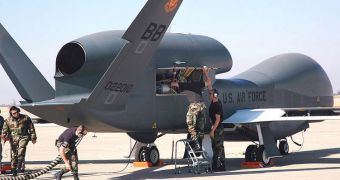In an event that could mark the beginning of an era, this month will see the first drone flight for scientific purposes. A Global Hawk Unmanned Aerial Vehicle (UAV) will take off from California, carrying a number of instruments that will allow it to measure the concentration of ozone, aerosols, and various other particles in the atmosphere. The airplane will fly in a 15,000-kilometer-long loop above the Hawaii islands, marking the first time such an advanced, slim-winged, high-flying jet is removed from its regular military surveillance duties, and put to good use in science, Nature News reports.
The scientists behind this flight hope to usher in a new type of scientific observations, that could see more and more of these UAV conducting similar experiments over large swaths of land. Because of their massive flight autonomy, these aircrafts can stay aloft for more than an entire day, producing massive amounts of scientific data in the process. Conducting similar experiments with human-controlled planes is a lot more expensive, as well as impractical. Pilots cannot fly for 24 to 36 hours without rest and refueling forces airplanes back on the ground at regular intervals.
The Global Hawk UAV will take off from a strip in the Mojave Desert later this month, and will conduct an accurate monitoring mission over the East Pacific Ocean. It will be guided by pilots located at the NASA Dryden Research Center, a facility capable of accommodating landing shuttles, which is located at the Edwards Air Force Base (EAFB). Analysts say that this is not the first time science has fiddled with UAV. Some agencies use them for many years, such as the Predator B aircrafts that NASA uses to survey Californian wildfires. But their reduced sizes made them impractical for long-duration, highly-demanding missions.
But the Global Hawk is different. With wingspans up to 35 meters, these aircrafts can carry the significant amount of scientific instruments needed to perform valid science. According to specifications provided by NASA, the UAV can lift about 900 kilograms to about 20,000 meters, and can fly non-stop for about 20,000 kilometers. These performances “can't even be approached with any other aircraft. Scientists don't really know how to use a platform like this, because we've never had one. You kind of have to let your imagination be unbridled for a bit, and then you rein it back in,” says the principal investigator of the National Oceanic and Atmospheric Administration (NOAA) drone project, David Fahey. The expert is based in Boulder, Colorado.

 14 DAY TRIAL //
14 DAY TRIAL //